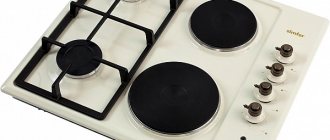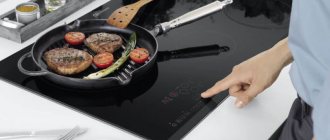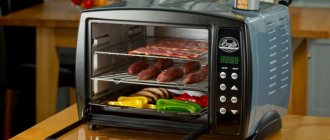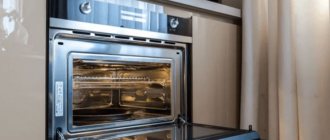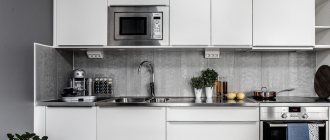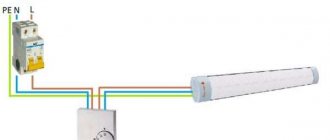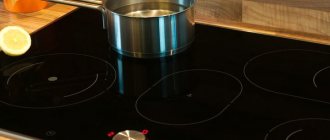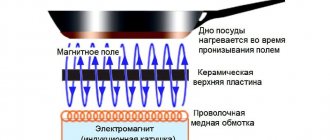Induction ovens are a recent invention of mankind. Gradually, the devices are gaining momentum, displacing gas competitors. The reason for this is the significant advantages of stoves , among which the low costs of energy consumption, heating only the lower surface, that is, the bottom of the cookware, practicality, ease of use and safety stand out. Before purchasing a product, a person should familiarize themselves with its characteristics, identifying all the advantages and disadvantages.
Features of induction devices and selection criteria
Modern models presented on the consumer market operate on a principle that is familiar to everyone from physics lessons. Cookware consisting of iron or steel elements is heated by a copper coil hidden under a glass or glass-ceramic panel. Any other devices made of other materials are not affected by the stove. Before you run to the store for new utensils, you should take the advice and bring your kitchen appliances to the stove . The device tends to attract certain elements due to its built-in magnet. If this process is observed, then the induction component will be able to act on the dishes, heating what is inside.
Models are divided into varieties according to certain factors.
- The dimensions of the devices can vary from medium to large . If a person actively uses the oven, then he will have to purchase large stoves.
- Internal equipment . Retractable panels, removable components, type of grilles - all this is selected according to the wishes of the buyer. The runners allow you to monitor the degree of preparation of the dish without removing it from the appliance.
- Functionality . The devices include a set of options, including several cooking modes and special functions. Before purchasing, you should pay attention to this aspect. In an induction oven you can cook pies, kebabs, bake meat or fish, and also create delicious desserts.
Installation of induction cookers
Installing and connecting ovens with electromagnetic coils with your own hands is not too different from working with similar kitchen appliances. Due to the high power, as always, you will need to draw an additional line from the panel and install a separate RCD. But if you are not very familiar with electrical installation, it is better to leave this part of the work to professionals.
It is also necessary to carefully study the equipment of the induction cooker. If a cord with a plug is provided here, the extended cable is connected to a grounded outlet; the presence of a terminal box indicates that the connection will have to be made directly and, most likely, to a three-phase network. It’s not difficult to do this with your own hands if you carefully study the diagrams in the instructions and correctly determine the phasing on both the terminal block and the three-core cable:
- The phases on the box are designated by the letters A, L (1 and 2), the return wire is in brown and black braiding.
- The zero is marked with the letters B or N and a wire in a blue sheath is thrown onto it.
- PE and yellow (or any other color) wire is grounding.
When connecting an induction stove with your own hands to a 220 V network, you must use an additional jumper, which is placed between the two phases.
Returning to the plug option, it is also worth paying attention to the characteristics of the socket. It must withstand the power that the induction cooker consumes and a current of at least 25 A. A prerequisite is that the socket and plug connectors completely match, since the use of adapters is unacceptable here.
Freestanding stoves do not require any complicated installation other than connecting them to the electrical outlet. But built-in two-module systems will force you to do a little more work with your hands in order to take a convenient place in the body of the kitchen cabinet. The installation procedure is as follows:
- Mark the countertop for installing the hob and use a jigsaw to cut a hole of the required size.
- If it is laminated chipboard, the ends must be treated with silicone sealant and a sealing tape must be placed on it to prevent water or debris from getting under the slab.
- Install the mounts for the induction furnace (included in the kit) in the cabinet and secure the electrical equipment to them.
- When installing an induction hob yourself, be sure to check the prepared fasteners with a short carpenter's level to make sure they are horizontal.
- Take the cord or power cable out and connect it to the network.
That's all you need to do the installation yourself, all that remains is to check how the induction furnace will perform in operation. Place a suitable thick-bottomed steel pan filled with water on the burner and turn on the heat.
Advantages of induction cookers
High-tech devices have entered the market with the goal of changing people's lives. In essence, these are the same gas stoves in design and appearance. Distinctive features are additional functions, efficiency and rationality of use.
- The units spend their energy specifically on heating the object located directly on the device. The cabinet does not heat the air in the room, distributing energy economically .
- Gas stoves have a significant drawback, which is the heating speed . Such problems do not occur with an induction oven. The surface instantly turns on, heats up and cooks food quickly.
- More possibilities . Induction ovens combine several devices at once. The devices are equipped with a range of functions: quick cooking, grilling and defrosting food.
- Easy to maintain and does not require much effort . Food placed on the surface does not burn and does not leave stubborn stains. That is why it is enough to wipe the surface with a damp cloth.
- Dishes cooked in the oven turn out healthy and low in calories . They are suitable for consumption by those who are watching their diet.
- Most models are equipped with a timer . You can set the time yourself or use a smart system that will not overcook or overcook the dish by turning off on time.
- There are several types of capacities , which you can choose yourself in exactly the same way as the diameter for containers.
- There are both separate models that combine a stove and oven, as well as built-in devices . Owners of small kitchens are recommended to use the second type of cabinets, install them in furniture and not clutter up the space.
- The unit can be located in any convenient place . The only dependence of the cabinet is on the presence of an outlet.
- Increased security . As soon as an object in the form of a pot, frying pan or stewpan moves from the burner a couple of centimeters, the automatic shutdown mechanism is activated.
Problems of induction - real and far-fetched
Everything that seems unusual causes mistrust, and the appearance of every technical innovation is often accompanied by myths and horror stories. In the case of induction hobs and ovens, this did not acquire much scope, since, in general, we all studied the principle of their operation in physics lessons at school.
Here the heating element does not increase its own temperature, but only affects the dishes if they have a sufficient iron content. All other items can be safely left on the induction hob - nothing will happen. This causes anxiety among housewives, who feel that they will now have to change all their pots and pans and buy a new set. In fact, most stainless steel and enameled steel utensils continue to work properly under induction.
To determine if your favorite pan is suitable for your new stovetop, simply hold a magnet to the bottom of it. If it is attracted, then the burner coil will also act on it.
However, induction ovens are actually quite selective when it comes to cookware. All models have restrictions on the diameter of the pan or stewpan installed on them - if the bottom is less than 12 cm (less often 8 cm), the coil will not turn on. On the one hand, this guarantees that a spoon accidentally left on the stove will not trigger the induction burner. On the other hand, your beloved Turk and small stewpans will still have to be sent to rest.
Not out of nowhere, the opinion arose that other household appliances should not be installed under an induction hob, since the electromagnetic field of the coils will also affect its operation. This is partly true, but modern manufacturers offer a way out of this situation for a small kitchen - to purchase models where the magnetic effect on surrounding metal objects is neutralized by a special heat sink.
Otherwise, the kitchen induction cooker is an excellent example of an easy-to-use and effective technology. This is no longer a myth, but a real fact. Although its power is no lower than that of other electric stoves, about 90% is spent on cooking. At the same time, conventional ovens spend a fair amount of energy heating the kitchen. Savings are achieved through several technical solutions at once:
- Automatically switches off the induction burner as soon as the bottom of the pan is a centimeter from the hob.
- Independently select a stove of sufficient power depending on the area of the bottom of the cookware.
- The presence of separate programs for cooking dishes without wasting energy - such an oven will not waste soup if it has already been cooked.
- Fast heating and higher cooking speed (about 1.5 times compared to gas burners), although, of course, you still have to get used to it.
When using induction cookers, do not forget that the glass ceramics on their surface do not heat up from the coils, but in contact with hot cookware it simply cannot remain cold. Be careful around the stove and do not touch the burners where food has just been cooked. To prevent accidental burns, many manufacturers equip their models with an indication of so-called residual heating.
Disadvantages of devices
The number of advantages significantly outweighs the disadvantages of induction ovens, however, it is worth talking about the disadvantages of the devices.
- Firstly, it is not recommended to place any other household appliances . The electromagnetic waves underlying the operation of the device can influence other types of devices, disrupting their performance. This problem is already beginning to be solved by introducing special diversion components that reduce or neutralize the impact of waves on other types of equipment.
- Secondly, the devices are somewhat more expensive than conventional gas stoves. As an alternative, you can purchase a small unit with one burner.
- Thirdly, not any material that can be used on other stoves is suitable for an induction cooker. You may need to replace some of the dishes. Suitable utensils include enamel, stainless steel, and cast iron.
- In addition, cookware with defects or unevenness on the bottom will heat unevenly . The bottom of pots and pans is required to have a smooth surface.
- The surface of the device can be subject to deformation : scratched or cracked from physical impact. For maintenance, it is recommended to purchase special lubricants that will allow you to maintain the original appearance of the device for a long time.
Rules for installing a stove over an oven
When choosing a classic installation option, namely, when the hob is located above the oven, you must adhere to the installation rules. The main condition is maintaining a gap for air circulation . If the induction tile is tabletop, then it has legs that create a gap above the table surface for ventilation. And if the stove needs to be built into the countertop, 2 cm around the device should remain free from any objects. This is the distance necessary for normal air flow circulation.
Each induction panel has thermal plugs on the bottom. They are located immediately below the coils and prevent magnetic waves and heat from spreading downward from the device. Maintaining the above clearance allows these heat traps to be cooled to a safe temperature. It is also desirable to have a complete absence of a back wall at the table where the induction surface will be placed. The distance between the wall and the device should be from 6 to 10 centimeters.
The operating instructions prohibit placing objects with magnetic properties immediately under the unit. In view of this, you should not place a drawer with cutlery under the tiles. Also, for the fan to operate normally, it is necessary to exclude the possibility of various debris or small objects getting into it. Therefore, it is better to leave this area completely empty. You can install a drawer only if the stove is combined, but only on the side of conventional electric burners.
To protect the saw cuts in the countertop from moisture, you need to treat them with sealants. And to prevent the leakage of various liquids onto the electrical parts of the appliance, it is necessary to place the tile not directly on the countertop, but using a special gasket, which is provided with the hob.
Important! It is necessary to remember the minimum distance from the hob to the lower section of wall furniture or the hood. It must be at least 650 mm. And the section with the slab itself must be securely fastened for stability.

